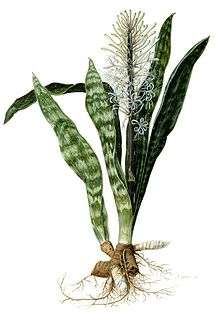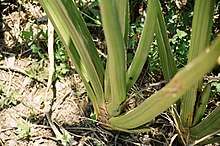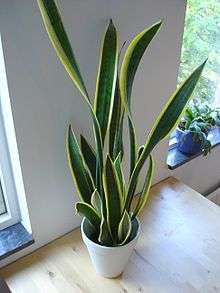Sansevieria
| Sansevieria | |
|---|---|
 | |
| Sansevieria hyacinthoides illustration c 1700 by Jan Moninckx | |
| Scientific classification | |
| Kingdom: | Plantae |
| Clade: | Angiosperms |
| Clade: | Monocots |
| Order: | Asparagales |
| Family: | Asparagaceae |
| Subfamily: | Nolinoideae |
| Genus: | Sansevieria Thunb.[1] |
| Synonyms[2] | |
| |

Sansevieria is a genus of about 70 species of flowering plants, native to Africa, Madagascar and southern Asia.[2] Common names include mother-in-law's tongue, devil's tongue, jinn's tongue, bow string hemp, snake plant and snake tongue.[3] It is often included in the genus Dracaena;[4] in the APG III classification system, both genera are placed in the family Asparagaceae, subfamily Nolinoideae (formerly the family Ruscaceae).[5] It has also been placed in the former family Dracaenaceae.
Description
There is great variation within the genus, and species range from succulent desert plants such as Sansevieria pinguicula to thinner leafed tropical plants such as Sansevieria trifasciata. Plants often form dense clumps from a spreading rhizome or stolons.[6][7]
Foliage
The leaves of Sansevieria are typically arranged in a rosette around the growing point, although some species are distichous. There is great variation in foliage form within the genus. All species can be divided into one of two basic categories based on their leaves: hard leaved and soft leaved species. Typically, hard leaved Sansevieria originate from arid climates, while the soft leaved species originate from tropical and subtropical regions.[6] Hard leaved Sansevieria have a number of adaptations for surviving dry regions. These include thick, succulent leaves for storing water and thick leaf cuticles for reducing moisture loss. These leaves may be cylindrical to reduce surface area and are generally shorter than those of their soft leafed tropical counterparts, which are wide and strap-like.[6]
Flowers
The flowers are usually greenish-white, also rose, lilac-red, brownish, produced on a simple or branched raceme. The fruit is a red or orange berry. In nature, Sansevieria flowers are pollinated by moths, but both flowering and fruiting are erratic and few seeds are produced.[6][7] The raceme of Sansevieria is derived from the apical meristem, and a flowered shoot will no longer produce new leaves. Unlike plants such as agave which die after flowering, a bloomed Sansevieria shoot will simply cease to produce new leaves. The flowered shoot continues to grow by producing plantlets via its rhizomes or stolons.
Taxonomy
Sansevieria is named for the Italian scientist and inventor Raimondo di Sangro [1710-71], Prince of Sanseviero.[8][9] The genus was originally named Sanseverinia by Vincenzo Petagna in 1787,[10] to honor his patron Pietro Antonio Sanseverino, Count of Chiaromonte (1724-1771), in whose garden Petagna had seen the plant.[11] In 1794, Thunberg, used the name Sansevieria.[10][12] It is not clear whether Thunberg's name was intended to be new, or was a typographical error for Petagna's name.[11] "Sansevieria Thunb." is a conserved name in the International Code of Nomenclature for algae, fungi, and plants, notwithstanding arguments that the author should be given as Petagna.[11][13]
The spellings "Sanseveria" and "Sanseviera" are commonly seen as well, the confusion deriving from alternate spellings of the Italian place name.
Sections
As of 2015 the genus was subdivided into three sections, one of which is further subdivided into three subsections:[14]
- sect. Sansevieria
- subsect. Sansevieria
- subsect. Hastifolia
- subsect. Solonifera
- sect. Dracomima
- sect. Cephalantha
Selected species
|
|
|
Formerly placed here
- Reineckea carnea iyot baka (Andrews) Kunth (as S. carnea Andrews)[16]
Uses
Rope and traditional uses
In Africa, the leaves are used for fiber production;[17] in some species, e.g. Sansevieria ehrenbergii, the plant's sap has antiseptic qualities, and the leaves are used for bandages in traditional first aid.[18][19]
Ornamental purposes

Several species are popular houseplants in temperate regions, with Sansevieria trifasciata the most widely sold; numerous cultivars are available. In China, the plant is usually kept potted in a pot often ornamented with dragons and phoenixes.[20] Growth is comparatively slow and the plant will last for many years. The tall-growing plants have stiff, erect, lance-shaped leaves while the dwarf plants grow in rosettes. As houseplants, Sansevieria thrive on warmth and bright light, but will also tolerate shade. They can rot from over-watering, so it is important that they are potted in well-drained soil, and not over-watered. They need to be re-potted or split at the root from time to time because they will sometimes grow so large that they break the pot they are growing in.
In Korea, potted Sansevieria is commonly presented as a gift during opening ceremonies of businesses or other auspicious events. In Barbados, Sansevieria is also popularly referred to as the "money plant", with the belief that the person having it will always have money. The belief seems to be based on an association of the colour (green) with the US bills.
Other Sansevieria species are less common in cultivation. Another species is Sansevieria cylindrica, which has leaves which look quite different from S. trifasciata, but is equally tough.
Sansevieria can be propagated by seed, leaf cutting, and division. Seeds are rarely used, as plants can normally be grown much faster from cuttings or divisions. As many cultivars are periclinal chimeras, they do not come true to type from leaf cuttings, and therefore must be propagated by rhizome division to retain the variegation.[21]
Scenery in film and television
Sansevieria has frequently been used as a set decoration in many films and TV shows, both in Hollywood and internationally, since at least the 1930s, including A Serbian Film, Being John Malkovich, Blue Velvet, Duck Soup, Groundhog Day, Homegrown, The Paper, and These Final Hours.
Air purification
According to a NASA Clean Air Study, along with other plants such as golden pothos (Epipremnum aureum) and corn plant (Dracaena fragrans), Sansevieria trifasciata is capable of purifying air by removing some toxins such as formaldehyde, xylene, and toluene.[22] Sansevieria use the crassulacean acid metabolism process, which absorbs carbon dioxide at night, although oxygen is released during daylight. Nighttime absorption of CO₂ purportedly makes them especially suitable bedroom plants. However, since the leaves are potentially poisonous if ingested, Sansevieria is not usually recommended for children's bedrooms.
Feng shui
According to feng shui, because the leaves of Sansevieria grow upwards, the plants can be used for feng shui purposes.[23][24] Some believe that having Sansevieria near children helps reduce coarseness, although care must be taken to ensure the child cannot reach the plant's poisonous leaves.[25] Others recommend placing pots near the toilet tank to counter the drain-down vibrations.[26] Such placement appears in the 1986 film Blue Velvet.
References
- ↑ "Genus: Sansevieria Thunb". Germplasm Resources Information Network. United States Department of Agriculture. 2010-01-19. Archived from the original on 2012-12-11. Retrieved 2010-10-29.
- 1 2 Kew World Checklist of Selected Plant Families
- ↑ Mbugua, P. K.; D. M. Moore. "Taxonomic studies of the genus Sansevieria (Dracaenaceae)". In L. J. G. van der Maesen; M. van der Burgt; J. M. van Medenbach de Rooy. The Biodiversity of African Plants (hardcover) (1st ed.). p. 880.
- ↑ Stevens, P.F. (2001–2012), Angiosperm Phylogeny Website: Asparagales: Nolinoideae
- ↑ Chase, M.W.; Reveal, J.L. & Fay, M.F. (2009), "A subfamilial classification for the expanded asparagalean families Amaryllidaceae, Asparagaceae and Xanthorrhoeaceae", Botanical Journal of the Linnean Society, 161 (2): 132–136, doi:10.1111/j.1095-8339.2009.00999.x
- 1 2 3 4 Stover, Hermine (1983). The Sansevieria Book.
- 1 2 Chahinian, B. Juan (2005). The Splendid Sansevieria: An Account of the Species. ISBN 987-43-9250-9.
- ↑ Coombes, Allen J. (2012). "The A to Z of Plant Names". Timber Press. ISBN 9781604691962 (hardback). pp 265
- ↑ Gledhill, David (2008). "The Names of Plants". Cambridge University Press. ISBN 9780521866453 (hardback), ISBN 9780521685535 (paperback). pp 339
- 1 2 "Plant Name Details for Sansevieria Thunb". The International Plant Names Index. Retrieved 2018-07-15.
- 1 2 3 Marais, W. (1973). "(350) Proposal to Amend the Entry of 1100. Sanseviera in the List of Nomina Generica Conservanda". Taxon. 22 (1): 158–159. JSTOR 1218069.
- ↑ "Section S". ICN: Appendix IIIA Nomina Generica Conservanda et Rejicienda. Retrieved 2018-07-15.
- ↑ Menale, Bruno; De Luca, Paolo & Del Guacchio, Emanuele (2013), "A plea to restore Petagna's authorship for the genus Sansevieria, nom. cons. (Liliaceae)", Taxon, 62 (2): 387–390, JSTOR taxon.62.2.387
- ↑ Mansfeld, P.A. Die Systematik der Gattung Sansevieria (Asparagaceae). Sansevieria Online 3(1). 2015.
- ↑ "Species: Sansevieria pinguicula P.R.O.Bally". GBIF. Retrieved 2011-01-27.
- 1 2 "GRIN Species Records of Sansevieria". Germplasm Resources Information Network. United States Department of Agriculture. Retrieved 2010-10-29.
- ↑ Kirby, F. Vaughan (1899). Sport In East Central Africa: Being An Account Of Hunting Trips In Portuguese And Other Districts Of East Central Africa.
- ↑ Chinasa, EC; Obodoike, EC & Chhukwuemeka, ES (2011), "Evaluation of anti-inflammatory property of the leaves of Sansevieria liberica ger. and labr. (fam: Dracaenaceae).", Asian Pac J Trop Med., 4 (10): 791–5, doi:10.1016/S1995-7645(11)60195-8
- ↑ Philip, D; Kaleena, PK; Valivittan, K & Girish Kumar, CP (2011), "Phytochemical Screening and Antimicrobial Activity of Sansevieria roxburghiana Schult. and Schult. F.", Middle-East Journal of Scientific Research, 10 (4): 512–8
- ↑ http://www.about-garden.com/a/en/1919-sansevieria-trifasciata-snake-plant
- ↑ R.W. Henley, A.R. Chase and L.S. Osborne - University of Florida, IFAS. "Sansevieria Production Guide".
- ↑ "Interior Landscape Plants for Indoor Air Pollution Abatement" (PDF). NASA.
- ↑ http://www.fengshuipalace.com/fs101/faq.shtml
- ↑ http://www.portlandnursery.com/plants/houseplantPicks/sansevieria-cylindrica.shtml
- ↑ "Archived copy". Archived from the original on 27 May 2010. Retrieved 19 April 2010.
- ↑ Englebert, Clear (2001). Bedroom Feng Shui. Crossing Press. p. 143. ISBN 1-58091-109-9.
External links
| Wikimedia Commons has media related to Sansevieria. |
| Wikispecies has information related to Sansevieria |